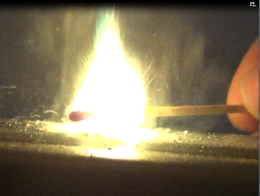Zinc peroxide
 Zinc Peroxide reacts to an open flame
| |
| Names | |
|---|---|
| IUPAC name
Zinc peroxide
| |
| Other names
Zinc dioxide
| |
| Properties | |
| ZnO2 | |
| Molar mass | 97.408 g/mol |
| Appearance | White-yellow solid |
| Density | 1.57 g/cm3 |
| Melting point | 212 °C (414 °F; 485 K) (decomposes) |
| Boiling point | (decomposes) |
| Insoluble | |
| Solubility | Insoluble in organic solvents |
| Acidity (pKa) | ~7 (3% solution) |
| Hazards | |
| Safety data sheet | Sigma-Aldrich |
| Related compounds | |
| Related compounds
|
Hydrogen peroxide |
| Except where otherwise noted, data are given for materials in their standard state (at 25 °C [77 °F], 100 kPa). | |
| Infobox references | |
Zinc peroxide, ZnO2, is a unique and chemically interesting compound of zinc. It is an insoluble zinc salt of hydrogen peroxide.
Contents
[hide]Properties
Chemical
Zinc peroxide is an oxidizer capable of sustaining energetic mixtures.
It was once used as an antiseptic, because it introduces large amounts of oxygen into the environment of anaerobic bacteria.
Zinc peroxide will react with diluted acids to release oxygen.[1] It, as a salt of a very weak acid and a very weak base, will also slowly decompose in water.[2]
Physical
Zinc peroxide is a white to bright yellow solid, insoluble in water. It has a density of 1.57 g/cm3. Zinc peroxide decomposes explosively if heated to 212 °C.[3]
Availability
Zinc peroxide is sold by dentistry suppliers, usually 60% pure.
Production
Zinc peroxide can be made by reacting concentrated hydrogen peroxide with zinc chloride. Zinc acetate can also be used.
A suspension of zinc oxide in hydrogen peroxide will eventually turn a shade of yellow as ZnO2 is formed but it does not go to completion in dilute peroxide and separating the two insoluble oxides formed this way is impossible. Some energetic properties can still be observed with this mixture however.
Projects
- Flash powder
- Antiseptic
Handling
Safety
Zinc peroxide is irritant to eyes, nose and mouth. Proper protection should be worn when handling the compound.[4]
Storage
Zinc peroxide should be stored in closed containers, away from moisture and acidic vapors.
Disposal
Zinc peroxide can be neutralized with acids.
References
- Jump up ↑ http://ec.europa.eu/health/ph_risk/committees/sccp/documents/out180_en.pdf
- Jump up ↑ Handbook for Pharmacy Technicians, By United States Department of the Army, p. 285
- Jump up ↑ http://cameochemicals.noaa.gov/chemical/1724
- Jump up ↑ http://www.t3db.ca/system/msds/attachments/000/000/786/original/T3D0737.pdf